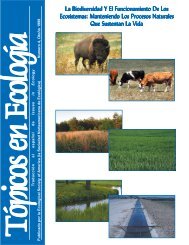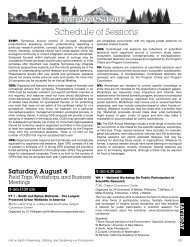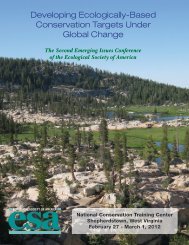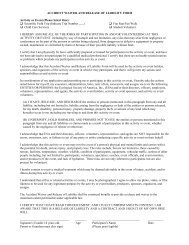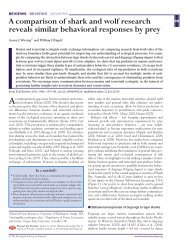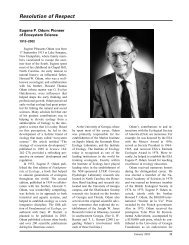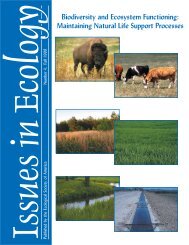Printed Program (PDF) - Ecological Society of America
Printed Program (PDF) - Ecological Society of America
Printed Program (PDF) - Ecological Society of America
You also want an ePaper? Increase the reach of your titles
YUMPU automatically turns print PDFs into web optimized ePapers that Google loves.
WEDNESDAY<br />
4:30 pm-6:30 pm<br />
Native-exotic species richness relationships across spatial<br />
scales in a prairie restoration matrix.<br />
PS 43-33 Nelson, JM, JR Peebles, TO Crist and DL Gorchov, Miami<br />
University. The effects <strong>of</strong> White-tailed deer (Odocoileus<br />
virginianus) and Amur honeysuckle (Lonicera maackii) on<br />
native forest floor plants and associated ant communities<br />
in SW Ohio.<br />
PS 43-34 Masters, JA, AN Bryant, MM Carreiro and SM Emery,<br />
University <strong>of</strong> Louisville. The impact <strong>of</strong> bush honeysuckle<br />
(Lonicera maackii) removal on arthropod diversity in an<br />
urban forest.<br />
PS 43-35 Smith, JR1, SN Murray2, SC Vogt2, FN Creedon2 and<br />
DJ Eernisse2, (1)California State Polytechnic University,<br />
Pomona, (2)California State University, Fullerton. Nonnative<br />
seaweeds on urban southern California rocky<br />
shores: Effects on native community structure and trophic<br />
dynamics.<br />
PS 43-36 Lekberg, Y1, AC Cornell1 and PA Olsson2, (1)MPG Ranch,<br />
(2)Lund University. Do invasive plants alter soil microbial<br />
communities and does this influence plant competitive<br />
interactions.<br />
PS 43-37 Johnston, CA and DS Gruner, University <strong>of</strong> Maryland.<br />
Foraging patterns <strong>of</strong> an invasive predator, Eleutherodactylus<br />
coqui, indicate potential direct and indirect effects on<br />
invertebrate prey food webs.<br />
PS 44 - Invasion: Dynamics, Population Processes<br />
Exhibit Hall DE, Oregon Convention Center<br />
PS 44-38 Zenni, RD and D Simberl<strong>of</strong>f, The University <strong>of</strong> Tennessee.<br />
Number <strong>of</strong> source populations as a potential driver <strong>of</strong> pine<br />
invasions in Brazil.<br />
PS 44-39 Kelly, LJ1, RN Mack1 and SJ Novak2, (1)Washington State<br />
University, (2)Boise State University. Genetic variation<br />
in Bromus tectorum (Poaceae) from the Mediterranean<br />
Region: Biogeographical history <strong>of</strong> native populations.<br />
PS 44-40 Marko, K1, H Lee II1 and D Reusser2, (1)U.S. Environmental<br />
Protection Agency, (2)USGS. Nonindigenous near-coastal<br />
and estuarine species in the North Pacific: Similarities and<br />
disparities in species invasion patterns.<br />
PS 44-41 Maines, AP and TR Seastedt, University <strong>of</strong> Colorado<br />
at Boulder. Effects <strong>of</strong> disturbance and site on spotted<br />
knapweed (Centaurea stoebe) seedling establishment in<br />
Colorado.<br />
PS 44-42 Taylor, K1, B Maxwell1 and A Pauchard2, (1)Montana State<br />
University, (2)Universidad de Concepción, Instituto de<br />
Ecología y Biodiversidad (IEB). Drivers <strong>of</strong> Pinus contorta<br />
invasion in Patagonia, Chile.<br />
PS 44-43 Maxwell, BD, T Brummer, PG Lawrence, EA Lehnh<strong>of</strong>f, J<br />
Rotella and LJ Rew, Montana State University. An empirical<br />
assessment <strong>of</strong> a Linaria dalmatica invasion in Yellowstone<br />
National Park.<br />
PS 44-44 Marchini, GL and MB Cruzan, Portland State University.<br />
Competitive interactions in a newly invasive plant,<br />
Brachypodium sylvaticum.<br />
PS 44-45 Altamirano-Vázquez, HG1, C Martínez-Peralta2, J Golubov<br />
Sr.3, M Rojas-Aréchiga2 and MC Mandujano4, (1)Depto. El<br />
hombre y su ambiente, (2)Instituto de Ecología, Universidad<br />
Nacional Autónoma de México, (3)Universidad Autónoma<br />
Metropolitana, (4)Instituto de Ecología. Universidad<br />
PS 44-46<br />
Nacional Atónoma de México. Germination <strong>of</strong> the succulent,<br />
invasive species Kalanchoe delagoensis.<br />
Wilson, CE, JR Albers, IJ Csargo and AC Kraemer, University<br />
<strong>of</strong> St. Thomas. Demographic variation among sites within a<br />
continuous population <strong>of</strong> Rhamnus cathartica.<br />
PS 45 - Invasion: Ecosystem Processes<br />
Exhibit Hall DE, Oregon Convention Center<br />
PS 45-47 Sheley, RL1 and S Bansal2, (1)USDA-ARS, (2)United States<br />
Department <strong>of</strong> Agriculture. Plant litter effects on nutrient<br />
mineralization and vegetation dynamics in sage-steppe<br />
communities with differing levels <strong>of</strong> annual grass invasion.<br />
PS 45-48 Schuster, MJ and JS Dukes, Purdue University. Non-additive<br />
decomposition <strong>of</strong> native-invasive tree litter mixtures.<br />
PS 45-49 Oleksy, IA1, AM Handler2, N Rigolino3, DC Arscott4, CA<br />
Gibson5, T Hoellein6 and DC Richardson3, (1)University<br />
<strong>of</strong> New Hampshire, (2)Franklin & Marshall College, (3)<br />
SUNY New Paltz, (4)Stroud Water Research Center, (5)<br />
Skidmore College, (6)Loyola University. A spatial analysis <strong>of</strong><br />
Didymosphenia geminata (rock snot) in the New York City<br />
watershed.<br />
PS 45-50 McCleery, TL1 and DF Cusack2, (1)UCLA, (2)UC - Los<br />
Angeles. Invasive tree species in tropical forests along an<br />
urban-rural gradient.<br />
PS 45-51 Lee, MR and JP Wright, Duke University. Linking species<br />
with their effects on ecosystem processes: Can an invasive<br />
species’ density and relative abundance account for<br />
variability in soil net nitrification potential?.<br />
PS 46 - Invasion: Invasibility, Stability, And Diversity<br />
Exhibit Hall DE, Oregon Convention Center<br />
PS 46-52 Huebner, CD, USDA Forest Service. Survivorship and<br />
productivity <strong>of</strong> invasive plant species in response to<br />
different forest management regimes across regional and<br />
local environmental gradients.<br />
PS 46-53 Hilbig, BE and EB Allen, University <strong>of</strong> California, Riverside.<br />
Effects <strong>of</strong> soil inocula on the growth responses <strong>of</strong> native<br />
annual forbs and the invasive annual grass, Bromus<br />
diandrus.<br />
PS 46-54 Brainard, AS and KL Schulz, State University <strong>of</strong> New York<br />
College <strong>of</strong> Environmental Science and Forestry. Propagule<br />
pressure and disturbance as drivers <strong>of</strong> invasive macrophyte<br />
abundance in public versus private lakes.<br />
PS 46-55 Shaff, SE1, DA Pyke1, AI Lindgren1, EW Schupp2, J<br />
Burnham2, PS Doescher3 and J Chambers4, (1)U.S.<br />
Geological Survey, (2)Utah State University, (3)Oregon<br />
State University, (4)USDA Forest Service. Inter-perennial<br />
gaps may indicate invasibility <strong>of</strong> sagebrush systems.<br />
PS 46-56 Chaneton, EJ, AI Bonomo and MG Longo, IFEVA - Facultad<br />
de Agronomía, Universidad de Buenos Aires. Plant richness<br />
and composition within a native functional group control<br />
invasion success in grassland microcosms.<br />
PS 46-57 Chupp, AD and LL Battaglia, Southern Illinois University.<br />
Disease induced canopy gaps and the persistence niche.<br />
PS 46-58 Satterlee, SR, IJ Renne and TP Diggins, Youngstown State<br />
University. Landscape and successional influences on plant<br />
invader success in a primary successional riparian zone.<br />
PS 47 - Invasion: Prevention And Management<br />
Exhibit Hall DE, Oregon Convention Center<br />
PS 47-59 Seiler, LK, DR Decoteau and DD Davis, Penn State<br />
University. Exploring Ailanthus altissima as a bioindicator <strong>of</strong><br />
ozone pollution.<br />
PS 47-60 Lehnh<strong>of</strong>f, EA1, MG Hohmann2, PG Lawrence1, BD<br />
Maxwell1 and LJ Rew1, (1)Montana State University, (2)US<br />
Army Corps <strong>of</strong> Engineers ERDC - CERL. Monitoring invasive<br />
plant populations for management efficacy: Problems and<br />
solutions.<br />
PS 47-61 Davis, C1, CS Brown1 and SM Esser2, (1)Colorado State<br />
University, (2)Rocky Mountain National Park. Effects <strong>of</strong><br />
selective imazapic application on Bromus tectorum and<br />
non-target species in Rocky Mountain National Park.<br />
PS 47-62 Gazal, R1, ML Burkowski1, RM Thomas1, M Takase2, K<br />
Gyokusen2 and K Otsuki2, (1)Glenville State College,<br />
(2)Kyushu University. Leaf structure and physiological<br />
attributes <strong>of</strong> Ailanthus altissima in cool and warm temperate<br />
regions.<br />
PS 47-63 Watts, AL, University <strong>of</strong> Washington. Identifying stand<br />
attributes correlated to the presence <strong>of</strong> Ilex aquifolium<br />
(English holly) within a Pacific Northwest forest.<br />
PS 47-64 Shrestha, S, KR Hickman and GWT Wilson, Oklahoma<br />
State University. Assessing plant-soil feedbacks following<br />
biological invasions: Implications for restoration.<br />
PS 47-65 Board, DI1, JC Chambers2, RO Jones3, DW Johnson4<br />
and RR Blank5, (1)USDA Forest Service Rocky Mountain<br />
Research Station, (2)USDA Forest Service, (3)University<br />
<strong>of</strong> Nevada-Reno, (4)University <strong>of</strong> Nevada, Reno, (5)USDA<br />
Agricultural Research Service. Effects <strong>of</strong> repeated burning<br />
<strong>of</strong> cheatgrass (Bromus tectorum) dominated ecosystems on<br />
plant density, biomass and seed production: Implications<br />
for restoration.<br />
128 ESA 97th Annual Meeting, August 5 - 10, 2012, Oregon Convention Center



